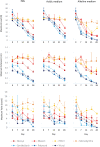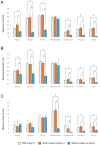A basic study on the mechanical properties of synthetic absorbable sutures under various pH conditions in vitro
- PMID: 40254418
- PMCID: PMC12159183
- DOI: 10.1292/jvms.25-0028
A basic study on the mechanical properties of synthetic absorbable sutures under various pH conditions in vitro
Abstract
In veterinary surgery, the choice of suture is determined by the surgeon based on a combination of factors, such as differences in disassembly time, price, and suture site. However, no unified comparison has been made across companies, and the differences are often unclear. In this study, we compared the mechanical properties (maximum tensile load, maximum extension, and maximum twist) of seven synthetic absorbable sutures at baseline (day 0) and over time under different pH conditions (PBS: pH 7.2, acidic: pH 5.6, alkaline: pH 8.8). At baseline, the comparison showed no significant difference in tensile load, but monofilament sutures exhibited a significantly higher extension than multifilament sutures. In terms of twist, the results varied, with significantly higher values for PDS II and MonoSynthe, both of which are polydioxanone based, suggesting that material differences may have influenced the results. On the other hand, multifilament sutures showed lower values over time in all conditions compared to monofilament sutures. Therefore, it was concluded that multifilaments were more strongly affected by solution immersion than monofilaments and lost their mechanical properties earlier. The results also revealed distinct patterns in twist behavior over time, especially MonoSynthe exhibited much lower twist values under alkaline pH compared to other monofilament sutures. These results suggest that twist could be a valuable addition to conventional evaluation methods for suture characteristics. Further multifaceted evaluations will contribute to the development of more comprehensive selection criteria for sutures used in veterinary clinical practice.
Keywords: in vitro; mechanical property; pH condition; synthetic absorbable suture.
Conflict of interest statement
The authors declare that there are no conflicts of interest related to the research and publication of this study. No financial relationships, including sponsored seminars, grants, or consulting fees, have influenced the design, execution, or reporting of the work. All authors have disclosed any potential conflicts of interest to ensure transparency and minimize the risk of bias.
Figures



Similar articles
-
Evaluation of the tensile strengths of four monofilament absorbable suture materials after immersion in canine urine with or without bacteria.Am J Vet Res. 2004 Jun;65(6):847-53. doi: 10.2460/ajvr.2004.65.847. Am J Vet Res. 2004. PMID: 15198227
-
Tensile properties of synthetic, absorbable monofilament suture materials before and after incubation in phosphate-buffered saline.Vet Surg. 2020 Apr;49(3):550-560. doi: 10.1111/vsu.13326. Epub 2019 Oct 9. Vet Surg. 2020. PMID: 31599002
-
Mechanical and handling properties of braided polyblend polyethylene sutures in comparison to braided polyester and monofilament polydioxanone sutures.Arthroscopy. 2006 Nov;22(11):1146-53. doi: 10.1016/j.arthro.2006.06.013. Arthroscopy. 2006. PMID: 17084288
-
Optimal suture materials for contaminated gastrointestinal surgery: does infection influence the decrease of the tensile strength of sutures?Surg Today. 2012 Dec;42(12):1170-5. doi: 10.1007/s00595-011-0112-6. Epub 2012 Jan 5. Surg Today. 2012. PMID: 22218873
-
The Stress Relaxation Process in Sutures Tied with a Surgeon's Knot in a Simulated Biological Environment.Polim Med. 2016 Jul-Dec;46(2):111-116. doi: 10.17219/pim/68735. Polim Med. 2016. PMID: 28397451
References
-
- Biosyn. https://www.medtronic.com/en-us/healthcare-professionals /products/wound... [accessed on January 14, 2025].
-
- Ethicon. Wound closure manual. https://anwresidency.com/simulation/guide /resources/Ethicon_Wound_Closu... [accessed on January 14, 2025].
MeSH terms
LinkOut - more resources
Full Text Sources
Miscellaneous

